How to deal with slugs on peppers in a greenhouse: the most effective methods of protecting crops from the pest
If you find that holes of different sizes have appeared on the leaves of the bell pepper, it means that there is an uninvited guest in the greenhouse. It is not easy to meet it during the day, since it is a nocturnal pest. The sun's rays and temperatures above 25 degrees are destructive for it, which is why it looks for damp shelters in greenhouses, in the shade of weeds and compost heaps. His name is slug.
Find out how to protect your crop and get rid of the pest right now.
How to understand that pepper in a greenhouse is affected by slugs
Not everyone sees this as a problem. The clumsy mollusk does not inspire much fear. However, soon the slug will show what it is capable of: although its jaws are rather weak, it has an excellent appetite, and it eats everything that comes its way. It is difficult to detect pests during the day: they hide in dark and damp places, and at night they come out in search of food.
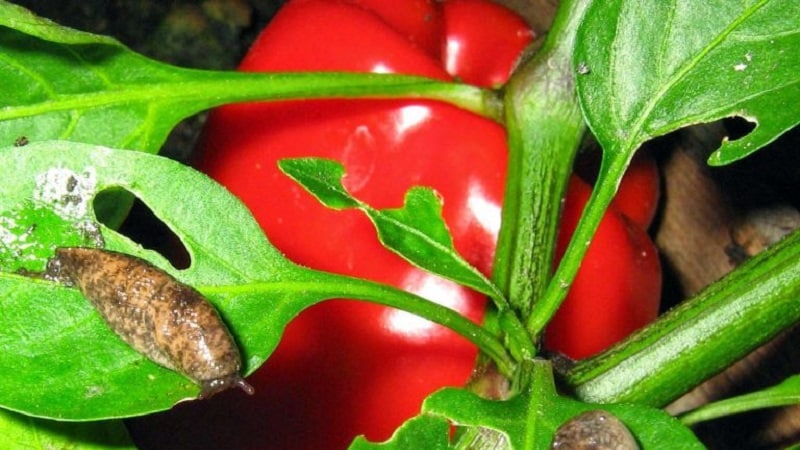
By the nature of damage on the leaves (holes) and traces of mucus near the plants you will realize that the pepper is in danger.
Damage caused
What terrible thing will happen to the plantings if the slugs gnaw a little on the foliage?? This is what inexperienced gardeners usually think. Let us hasten to dispel their misconceptions:
- Shellfish eat more than just leaves. When the fruits appear, they will transfer to them.
- By devouring greens, they inhibit the growth and development of peppers.
- Moving from plant to plant, they spread plant viruses and fungi. This is much more dangerous than all the active activities of slugs.By spreading diseases, they can destroy all greenhouse plants.
Physiology of slugs
This mollusk from the class of gastropods is a sibling of the snail, only without a shell.. Its body is long – up to 10 cm – and, as they say, “fat”. Due to muscle contraction, it can change significantly in size.
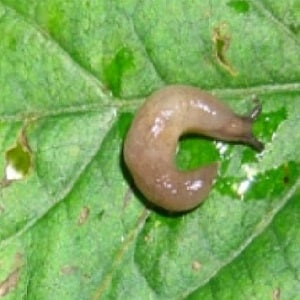 There are two pairs of tentacles on the head: optical and tactile. Optical, or ocular, tentacles are located on the very top of the head and help the slug distinguish light from darkness. Below are tactile tentacles - the organs of smell and touch. The tentacles have the ability to regenerate, that is, grow back if the slug suddenly loses them. There are only three openings on the body: the mouth, the pulmonary opening (on the side of the back) and the anus.
There are two pairs of tentacles on the head: optical and tactile. Optical, or ocular, tentacles are located on the very top of the head and help the slug distinguish light from darkness. Below are tactile tentacles - the organs of smell and touch. The tentacles have the ability to regenerate, that is, grow back if the slug suddenly loses them. There are only three openings on the body: the mouth, the pulmonary opening (on the side of the back) and the anus.
These creatures are hermaphrodites, so they fertilize each other regardless of gender. Eggs are laid in moist holes in the soil. Each individual can lay up to 30 eggs, from which new offspring will appear in two weeks. During the summer months, one slug lays an average of 500 eggs. The last autumn clutch overwinters in the soil until spring.
This is interesting. For protection from enemies and more gliding movement, they secrete mucus. Their natural enemies are moles, hedgehogs, shrews, lizards, snakes, frogs and some species of birds.
However, you cannot let birds and moles into the greenhouse, which means you need to use other methods for neutralizing slugs. What to do if slugs appear on peppers in a greenhouse, and how to deal with them - we’ll talk below.
Fighting methods
Choose the method of dealing with slugs depending on the size of the threat. Of course, it is better to do this using methods that do not disturb the ecosystem, but on the other hand, gentle means are not always effective if there are too many slugs.
Read also:
How to deal with spider mites on pepper seedlings
Chemicals
If the mollusks have attacked the greenhouse and are already behaving like owners, you should think about using chemicals. Manufacturers of modern chemicals face a double task: while maintaining the effectiveness of the drug, reduce the risk of harm to the external environment. Many drugs are safe for human health and pets and do not affect beneficial insect populations.
The following products are recommended for use:
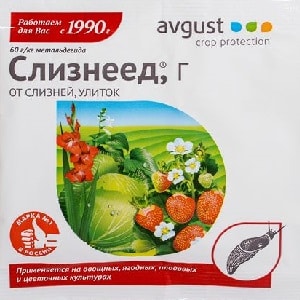 “Slug eater” is an affordable drug in granules. Treatment is carried out in the evening, when the mollusks are active. The product acts by penetrating the skin and digestive system, causing dehydration and leading to the death of slugs. The granules, entering the slug’s body, swell, absorbing all the moisture.
“Slug eater” is an affordable drug in granules. Treatment is carried out in the evening, when the mollusks are active. The product acts by penetrating the skin and digestive system, causing dehydration and leading to the death of slugs. The granules, entering the slug’s body, swell, absorbing all the moisture.- Pesticide "Thunderstorm Meta" (active ingredient – metaldehyde). Once in the digestive organs of slugs, it destroys them. Available in granules. The action lasts 2-3 weeks. Usually three times a season is enough to exterminate pests.
- Biological product "Ferramol" safe for animals, has an unpleasant smell and taste for them. Does not harm beneficial insects. It is available in granules and acts in the same way as Slug Eater.
Attention! Use chemicals to protect greenhouses from slugs strictly according to the instructions. Uncontrolled use is harmful to human and animal health.
Folk remedies
Traditional methods include all the tricks, skills and abilities that farmers use to kill slugs. They are based on observations of the habits of mollusks and have been used throughout the history of human struggle for the harvest.
Slugs are midnight creatures: they sleep during the day and feed at night.. They cannot tolerate heat and dryness, so they look for dark and damp places to hide. Since there is always high humidity in the greenhouse, slugs are more comfortable here than in beds under the scorching sun.
They usually hide and lay eggs in crevices in the soil. (pictured below), therefore, to get rid of the offspring of slugs, it is recommended to use 25% ammonia diluted with 10 liters of water. The solution is poured into crevices and cracks in the soil, but do not allow it to come into contact with plant leaves, as ammonia causes burns.
There are other methods for exterminating slugs in garden beds.:
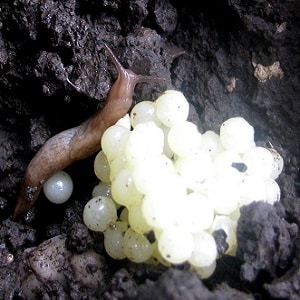 Simplest - sprinkle the beds with pepper with wood ash, slaked lime, mustard powder, hot ground pepper. If in contact with slugs or ingested, the substances will cause fatal burns.
Simplest - sprinkle the beds with pepper with wood ash, slaked lime, mustard powder, hot ground pepper. If in contact with slugs or ingested, the substances will cause fatal burns.- Using mustard in powder and solution. To do this, dilute half a pack of dry mustard in a bucket of water and leave for 2-3 hours. Spray the pepper foliage or water it with a garden watering can.
- As farmer experience shows, Treatment of plants with coffee solution is effective. Coffee grounds are scattered on the beds. Caffeine has a detrimental effect on slugs: strong coffee kills them, and weak coffee repels them. It must be remembered that a concentrated coffee solution causes a burn to the foliage and also destroys beneficial insects.
- Using Traps. In the vicinity of the plantings, plastic cups or other containers, for example, small tin cans, are dug up to the neck. Bait in the form of beer, juice or liquid jam is poured into containers one-third full. Slugs, attracted by the smell, will fall into such traps, and in the morning you can collect the “captives”.It is better to throw the collected slugs into a bucket with a salt solution that is harmful to them.
Important! Traditional methods of fighting slugs are carried out regularly, preferably in combination with other methods. This is the only way to achieve sustainable results.
Biomethods
Methods of biological control of slugs include the participation of representatives of flora and fauna. Let's take a closer look at methods suitable for use in greenhouses:
- Distracting plants. Planting plants that slugs can “switch” to. For example, shellfish like seed rape. If you make a rapeseed lawn in front of the entrance to the greenhouse, the attention of slugs will be attracted to this plant.
- Slug repellent plants. Planting herbs such as parsley, dill, sage, rosemary, and thyme inside the greenhouse will discourage slugs from being in the greenhouse; they will find more comfortable conditions for themselves.
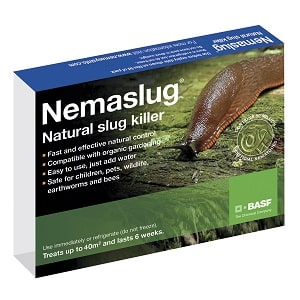 Imported biological preparation against slugs Phasmarhabditis hermaphrodit (Nemaslug), containing a parasitic nematode, that is, a microworm that will destroy the entire generation of slugs in the greenhouse. The nematode is sown in the soil, from there it moves onto the slug’s body and kills it. The condition for the development of nematodes is high soil moisture. Microworms are not dangerous to humans, animals, plants and beneficial insects; they are only “interested” in slugs. The effect of such a fight is long-lasting, it lasts for a whole season.
Imported biological preparation against slugs Phasmarhabditis hermaphrodit (Nemaslug), containing a parasitic nematode, that is, a microworm that will destroy the entire generation of slugs in the greenhouse. The nematode is sown in the soil, from there it moves onto the slug’s body and kills it. The condition for the development of nematodes is high soil moisture. Microworms are not dangerous to humans, animals, plants and beneficial insects; they are only “interested” in slugs. The effect of such a fight is long-lasting, it lasts for a whole season.- Toads, frogs and lizards – helpers in the fight against slugs in the greenhouse. These amphibians do not touch plants, but they will not refuse to snack on slugs. How many frogs to have depends on the size of the greenhouse and the number of slugs.
Mechanical removal
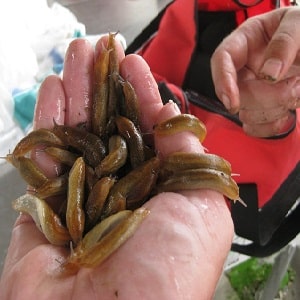 The most popular technique among summer residents is manual collection of slugs.. They are collected directly from the leaves, using tweezers so as not to injure the plant, or they place objects in the greenhouse that the mollusks will take for good shelter. As such items, use everything that is at hand: boards, rags, sheets of plywood, linoleum, brooms. By evening, place the available products in the greenhouse and moisten them.
The most popular technique among summer residents is manual collection of slugs.. They are collected directly from the leaves, using tweezers so as not to injure the plant, or they place objects in the greenhouse that the mollusks will take for good shelter. As such items, use everything that is at hand: boards, rags, sheets of plywood, linoleum, brooms. By evening, place the available products in the greenhouse and moisten them.
Slugs will be attracted to new hiding places and will flock to the traps. In the morning, lifting a broom or board, you will see piles of slugs under them. Place detected pests in a bucket and destroy them in an acceptable way - burn them or treat them with saline solution.
Mechanical methods also include physical obstaclesthat prevent slugs from crawling from plant to plant:
- Plastic gutters, filled with water, which surround the beds around the perimeter. Such gutters can also be filled with coffee grounds, which will repel pests.
- Dry porous material, which is sprinkled between rows of beds: crushed eggshells, fine gravel. Such material should not be watered, it should always remain dry, preventing the slug from sliding.
- Specially produced granules Slug Stoppa Granules, absorbing moisture and mucus, also prevent the movement of slugs. They are scattered on the ground around the plants.
It can be useful:
Preventive measures
Experienced farmers know the problems they will face next season, so they carry out a set of measures to protect peppers from slugs, increasing plant immunity and reducing the level of favorable conditions for the reproduction of pests.
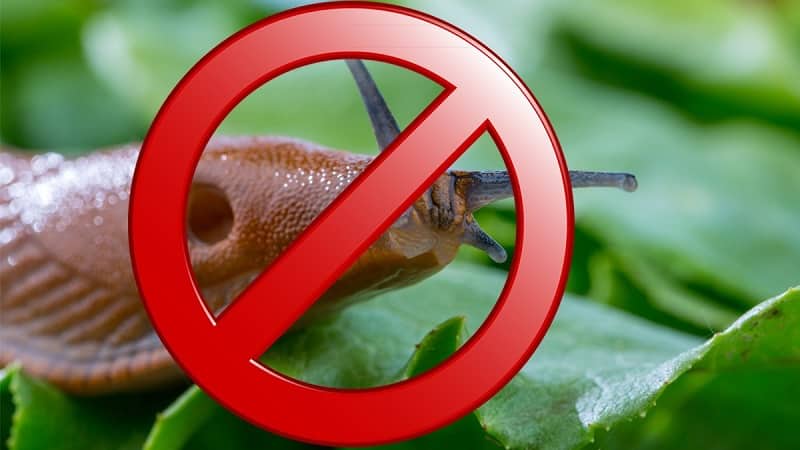
The following agrotechnical measures against slugs are used both in open ground and in greenhouses:
- Digging and loosening the soil. Clutches of eggs and adult slugs overwinter in the ground. Frequent loosening and autumn digging will prepare the soil for spring planting - it will be free of pest larvae.
- Rotation of crops in one area. This approach prevents slugs from breeding in the soil.
- Careful approach to seed selection, planting disease-resistant plants.
- Removal during germination of weak ones and underdeveloped plants.
- Regular ventilation of the greenhouse, keeping them clean: all debris, foreign objects, remains of plants and leaves are removed in a timely manner. Clean tubs, pots, and racks for seedlings from rotten parts of plants and wash them.
- Weeding beds, removing rotting lower leaves and stems, improving air circulation between plantings.
- Immediate removal soil infested with larvae.
- Keep the soil for planting outside the greenhouse, preferably in direct sunlight, so as not to infect with larvae.
Conclusion
An agrotechnical approach to greenhouse pepper cultivation is a labor-intensive but effective process for preventing slug attacks on plantings. After all, fighting slugs is not a one-day task. It should include a strategic plan for the prevention of pests in greenhouses and a set of measures for their extermination.
It must be remembered that all folk and mechanical methods against mollusks only work if they are used regularly. Do not exclude the possibility of introducing toads, frogs and lizards into greenhouses - they will help cope with the task.